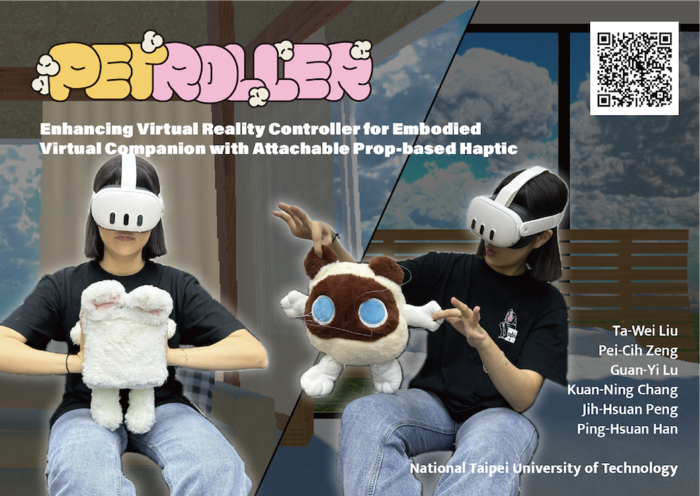Taipei Tech’s XR Therapy Cat Takes Top Prize at SIGGRAPH Asia Achievements

A team from Taipei Tech’s Department of Interaction Design has developed an innovative pet robot named “Petroller,” designed to interact with users in an extended reality (XR) manner and provide emotional support to assist with rehabilitation effort. The device provides tactile, visual, and auditory feedback, letting users feel like they are interacting with a real cat. Petroller won the Best Demo Award in the XR Demo section at SIGGRAPH Asia 2024 in Tokyo, drawing significant attention from global manufacturers and developers.
As global aging drives demand for healthcare and assistive technologies, Medi-Tech Insights, a Belgium-based healthcare consulting firm, predicts the care robot market will expand annually by nearly 20% from 2024 to 2029. Recognizing this opportunity, Associate Professor Han Ping-hsuan guided students Liu Ta-wei, Tseng Pei-tzu, Lu Guan-yi, Chang Kuan-ning, and Peng Jih-hsuan to create Petroller, designed explicitly for therapeutic rehabilitation and companionship.
When users wear a VR headset, the fuzzy Petroller transforms into a lifelike virtual cat through extended reality. By interacting with the physical device—such as tugging its ears, pressing on it, or squeezing it between the thighs—users trigger virtual reactions like facial expressions and emotional sounds. These simulate the nuanced behavior of a real cat, making the experience feel deeply authentic. This emotional feedback, combined with subtle physical movements, helps support rehabilitation in a way that is both comforting and engaging—especially for those familiar with the companionship of pets.
At the SIGGRAPH Asia event, many visitors were drawn to Petroller’s calming, lifelike purring sounds. Tseng, a graduate student involved in the project, noted that many participants could not help but smile upon hearing the virtual cat’s first meow.
Professor Han highlighted that Petroller addresses common shortcomings of existing pet robots, such as limited expressive interactions and the need for constant charging. Petroller incorporates passive components, which allow for seamless integration with any headset without requiring additional power sources, making Petroller simpler and more cost-effective for mass production. The team is eager to explore and expand Petroller’s potential applications in the future.
As global aging drives demand for healthcare and assistive technologies, Medi-Tech Insights, a Belgium-based healthcare consulting firm, predicts the care robot market will expand annually by nearly 20% from 2024 to 2029. Recognizing this opportunity, Associate Professor Han Ping-hsuan guided students Liu Ta-wei, Tseng Pei-tzu, Lu Guan-yi, Chang Kuan-ning, and Peng Jih-hsuan to create Petroller, designed explicitly for therapeutic rehabilitation and companionship.
When users wear a VR headset, the fuzzy Petroller transforms into a lifelike virtual cat through extended reality. By interacting with the physical device—such as tugging its ears, pressing on it, or squeezing it between the thighs—users trigger virtual reactions like facial expressions and emotional sounds. These simulate the nuanced behavior of a real cat, making the experience feel deeply authentic. This emotional feedback, combined with subtle physical movements, helps support rehabilitation in a way that is both comforting and engaging—especially for those familiar with the companionship of pets.
At the SIGGRAPH Asia event, many visitors were drawn to Petroller’s calming, lifelike purring sounds. Tseng, a graduate student involved in the project, noted that many participants could not help but smile upon hearing the virtual cat’s first meow.
Professor Han highlighted that Petroller addresses common shortcomings of existing pet robots, such as limited expressive interactions and the need for constant charging. Petroller incorporates passive components, which allow for seamless integration with any headset without requiring additional power sources, making Petroller simpler and more cost-effective for mass production. The team is eager to explore and expand Petroller’s potential applications in the future.






